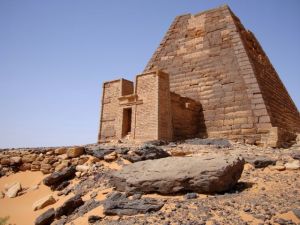Who can think of the Middle East without forming a mental image of pyramids?
Despite ideas of golden sarcophaguses and huge temples, it is important to note that not all pyramids are created equal. My visit to Sudan included a stop at the Kushite (25th Dynasty) site of Merowe, near the 6th Cataract of the River Nile. Here the pyramids are much, much less massive than the more famous Giza pyramids outside Cairo. And they’re thinner, pointier, different. Not quite right.
But, these pyramids are famous in their own right . . . they’re featured on the back of the US $1 bill with the all-seeing eye floating above!
Why?
A lot of speculation exists, conspiracy theories that label George Washington and the other founding fathers of the United States as having planned world domination and planted secret guiding symbols in plain sight.
Seeing the pyramids at Merowe, drifted over in red sand, crumbling, covered with graffiti, it is hard to imagine that any particular intent, any forethought, went into the choice of an obscure, skinny tomb for the Great Seal of the United States. Yet I wonder, what artist decided on this particular type of pyramid for the dollar bill? How did he know its dimensions, its form and tilt? Did he visit Merowe? And, why, why are all these little pyramids decapitated, flattened at the top . . . just as if the eye was meant to float there?
It’s a mystery that will probably never be answered, a little piece of not quite right that I’ve carried around in my wallet, never wondering, for far too long.



March 28th, 2011 at 4:21 pm
Hmmmm. . . Had to get out a dollar bill and look. Never thought about this, I wonder why this was chosen? Food for thought.
March 29th, 2011 at 1:41 am
I always thought the pyramid on the back of the dollar bill was a full pyramid with the peak raised up.
March 29th, 2011 at 1:01 am
We all know that extraterrestrials help build the pyramids right? Hehe.